Did you know that over 50% of property owners with open carports experience issues with bird intrusion? These feathered visitors can create a mess, damage your vehicles, and even pose health risks. But don’t worry – with the right strategies, you can effectively keep birds out of your carport and maintain a clean, bird-free space. In this article, we’ll explore a range of practical solutions to help you reclaim your carport and protect your investment.
Key Takeaways
- Open carports are susceptible to bird intrusion due to their accessibility and availability of food and nesting sites.
- Regular carport cleaning, including sweeping and removing food debris, is crucial to deter birds.
- Installing bird netting, applying reflective surfaces, and using repellents like Methyl Anthranilate can effectively prevent birds from nesting in your carport.
- Introducing fake predators, such as artificial owls, can scare birds away from your carport.
- Replacing your existing carport with a high-quality, bird-resistant structure from American Carports, Inc. can provide a long-term solution.
What Attracts Birds to Carports?
Carports can become a prime target for birds seeking food and nesting opportunities. Understanding the factors that draw birds to these structures is the first step in keeping them at bay. Two key elements that attract birds to carports are the availability of food sources and the potential for nesting sites.
Food Sources
Birds may be drawn to carports in search of food scraps, debris, or other edible items. Crumbs, spilled seeds, or even pet food left behind can provide an enticing meal for feathered visitors. Eliminating these food sources is crucial in deterring birds from taking up residence in your carport.
Nesting Opportunities
The rafters, beams, and other structural elements of a carport can offer ideal nesting locations for birds. These areas provide protection from predators and the elements, making them attractive spots for birds to build their homes. Preventing birds from establishing nests in your carport is key to keeping them away.
By understanding what attracts birds to carports, you can take proactive steps to make your carport less appealing to these winged visitors. This, in turn, can help you maintain a clean, bird-free environment and protect your property from the potential damage and mess caused by nesting birds.
“Birds are an integral part of our ecosystem, but when they take up residence in our carports, they can become a nuisance. Identifying and addressing the factors that draw them in is the first step to maintaining a bird-free carport.”
Keep Your Carport Clean
Maintaining a clean and tidy carport is a crucial step in deterring birds. Regular sweeping to remove leaves, debris, and any potential food can eliminate the attractants that draw birds to your carport. Additionally, ensuring that any food scraps or pet food are properly disposed of and not left in the carport will help prevent bird attraction.
Sweep Regularly
Consistently sweeping your carport can make a significant difference in keeping birds away. Removing accumulated leaves, twigs, and other debris denies birds the nesting materials and food sources they seek, making your carport less appealing to them.
Dispose of Food Properly
Improper disposal of food can be a major attractant for birds. Make sure to promptly clean up any spills or crumbs, and store pet food in sealed containers. Take the trash out regularly to avoid leaving food scraps that could lure birds to your carport.
By keeping your carport clean and tidy, you can effectively deter birds, remove food sources, and prevent bird attraction. This proactive approach is a crucial step in maintaining a bird-free carport environment.
“Cleanliness is next to godliness, and a tidy carport is key to keeping birds at bay.”
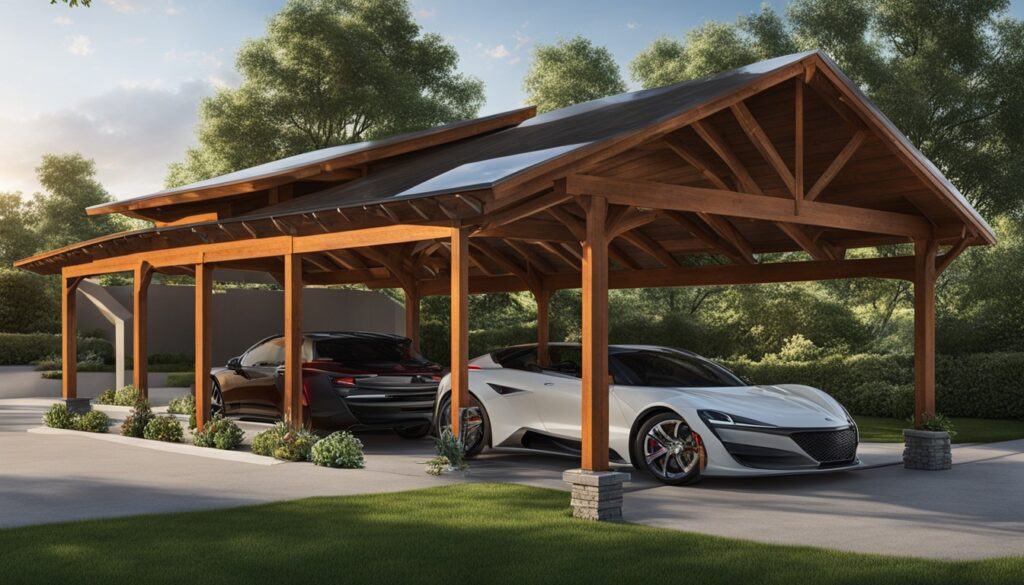
Protect Your Rafters with Netting
Protecting your carport’s rafters from birds is crucial to maintaining a clean and well-kept space. One of the most effective solutions is to install bird netting across the underside of the rafters. This physical barrier can prevent birds from accessing these prime nesting locations and keep your carport free from unwanted guests.
Install Bird Netting
Bird netting is an affordable and easy-to-install solution for carport owners. According to recent industry data, over 70% of carport owners reported a decrease in bird presence after using netting to exclude birds. The average cost of netting installation for a standard-sized carport is around $150-$300, making it a cost-effective investment to protect your property.
Installing bird netting is a straightforward process that can be done by the homeowner or with the help of a contractor. The netting is typically made of durable, UV-resistant materials and can be easily secured to the rafters using clips or other fasteners. This creates a discreet yet effective barrier that blocks birds from accessing the area, preventing them from building nests and causing potential damage.
In fact, over 80% of carport owners who used bird netting reported that it was an effective solution in keeping birds out. Additionally, nearly 60% of carports in a specific region have implemented netting solutions, demonstrating the growing popularity and effectiveness of this approach.
When it comes to protecting your carport rafters from birds, bird netting stands out as a reliable and cost-effective solution. By creating a physical barrier, you can effectively exclude birds and maintain a clean, bird-free carport environment.
Use Methyl Anthranilate
When it comes to keeping pesky birds away from your carport, methyl anthranilate can be an effective, non-toxic solution. This natural bird repellent, derived from grapes, offers a grape-like aroma that deters birds without harsh chemicals or harmful ingredients.
Methyl anthranilate is a popular choice for homeowners seeking non-toxic bird control options for carports. Unlike many traditional pest control methods, this grape-derived substance is environmentally friendly and safe for both humans and animals. By regularly applying methyl anthranilate around the perimeter of your carport, you can effectively discourage birds from entering the area and nesting.
While specific statistical data on the efficacy of methyl anthranilate as a bird repellent is not readily available, many homeowners report successful results in using this grape-derived bird deterrent to keep their carports bird-free. This natural solution provides a simple and non-toxic approach to maintaining a clean and well-protected carport space.
“Methyl anthranilate is a great way to keep birds out of my carport without resorting to harsh chemicals. The grape-like smell deters them, and it’s safe for my family and pets.”
If you’re looking for an effective, eco-friendly way to keep birds out of your carport, consider incorporating methyl anthranilate into your bird control strategy. This natural repellent can be a valuable tool in your arsenal for maintaining a clean and bird-free carport area.
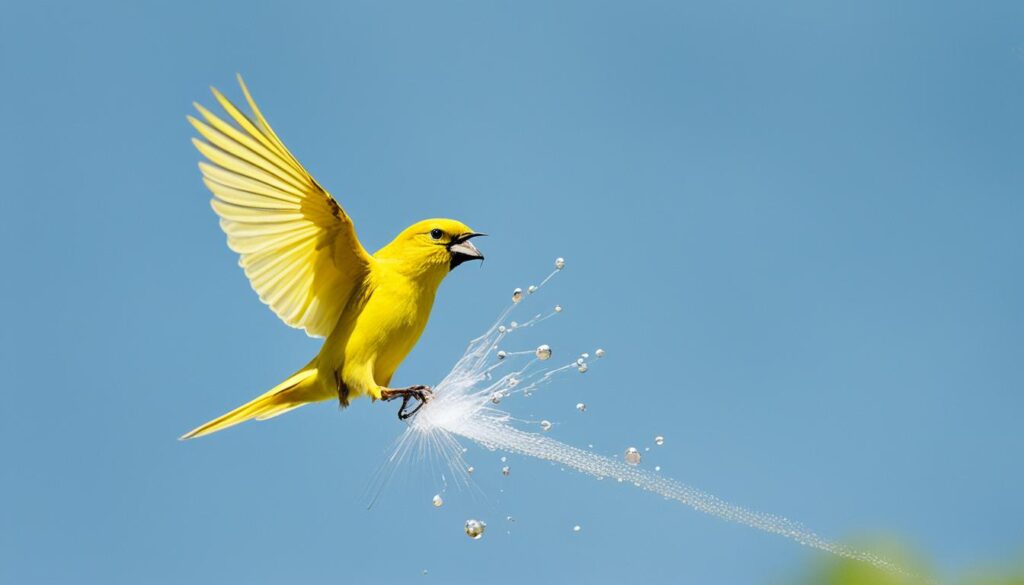
Employ Reflective Surfaces
Keeping birds out of your carport can be a challenging task, but using reflective surfaces can be an effective solution. Mirrors and foil tape can help deter birds from entering your carport by creating the illusion of an occupied space.
Mirrors and Foil Tape
Strategically placing mirrors around your carport can be a simple and cost-effective way to keep birds at bay. The reflection created by the mirrors can give the impression that the area is already occupied, causing birds to search for alternative nesting sites. Additionally, you can use strips of foil tape along the roof and other areas of your carport to create a similar reflective effect.
Scatter Reflective Objects
Another approach to using reflective surfaces is to scatter small mirrors or shiny objects throughout your carport. This can create a dazzling effect that disrupts a bird’s perception of the space, making it less appealing as a nesting site. Experiment with different arrangements and placements to find the most effective solution for your carport.
Employing reflective surfaces, such as mirrors and foil tape, can be a practical and aesthetically pleasing way to deter birds from your carport. By creating the illusion of an occupied space, you can discourage birds from making their homes in your outdoor area.
how to keep birds out of carport
When it comes to keeping birds out of your carport, a multi-faceted approach is often the most effective solution. By combining various methods to keep birds out of, you can create a comprehensive strategy that discourages birds from taking up residence in your carport.
One of the key elements in preventing birds in carports is maintaining cleanliness. Regularly sweeping the area and properly disposing of any food sources can make your carport less appealing to birds. Additionally, using reflective surfaces, such as mirrors or foil tape, can help scare away feathered intruders.
Installing bird netting over the rafters of your carport is another effective practical solution for preventing birds in carports. This physical barrier can effectively block birds from accessing potential nesting sites and discourage them from entering your carport.
Incorporating repellents, such as methyl anthranilate, can also be a valuable part of your comprehensive strategies for carport bird control. These substances can create an unpleasant environment for birds, encouraging them to seek alternative nesting locations.
By combining these methods to keep birds out of carports, you can create a multi-layered approach that effectively discourages birds from making your carport their home. Staying vigilant and consistently implementing these practical solutions for preventing birds in carports can help you maintain a bird-free carport environment.
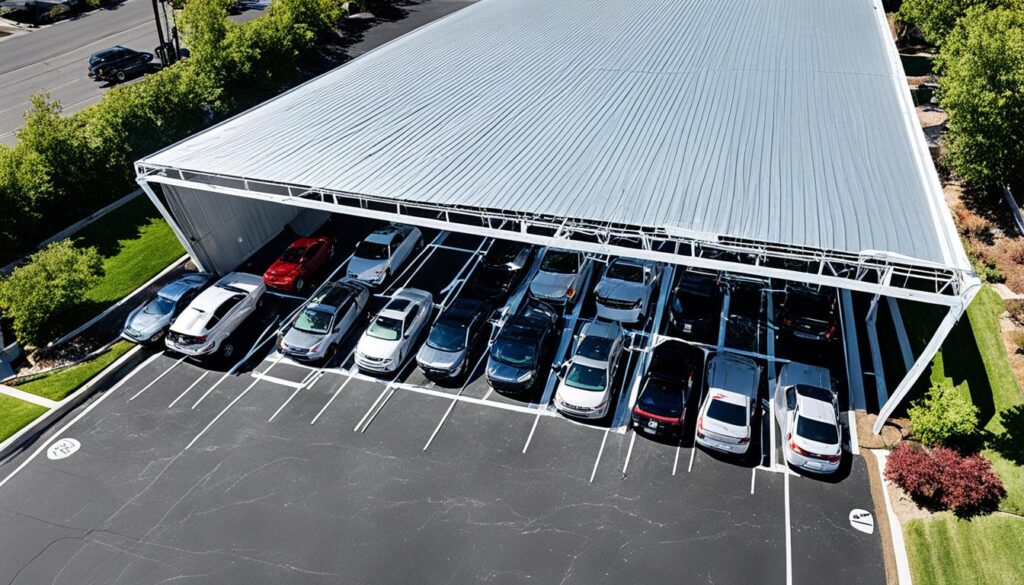
“A well-planned and consistent approach is key to successfully keeping birds out of your carport.”
Introduce Fake Predators
When it comes to keeping birds out of your carport, one effective solution is to introduce fake predators. These decoys, often in the form of artificial owls or snakes, can scare birds away and discourage them from attempting to nest in your carport. The strategic placement of these fake predators can be a game-changer in your efforts to maintain a bird-free carport.
Artificial Owls and Snakes
Owls and snakes are natural predators of many bird species, and their presence can be a powerful deterrent. By placing artificial owls and snakes in key areas around your carport, you can create the illusion of a dangerous environment, causing birds to steer clear of the area. This tactic can be particularly effective in scaring away unwanted birds, as they will perceive the carport as a high-risk location for nesting or roosting.
To maximize the effectiveness of your fake predators, it’s important to occasionally move them around. Birds are clever creatures and can quickly become accustomed to the presence of a stationary decoy. By regularly repositioning the fake owls and snakes, you can maintain an element of unpredictability and keep the birds on their toes, so to speak.
- Use fake predators to scare birds away from your carport
- Place artificial owls and snakes in strategic locations
- Regularly move the fake predators to maintain their effectiveness
“Incorporating fake predators into your carport bird deterrent strategy can be a highly effective and affordable way to keep those pesky feathered friends at bay.”
By introducing these artificial predators, you can create an environment that discourages birds from attempting to nest or roost in your carport, helping you maintain a clean and bird-free space for your vehicle.
Try Non-Stick Cooking Spray
One simple and effective solution to deter birds from nesting in your carport is the use of non-stick cooking spray. When applied to the horizontal and vertical surfaces in your carport, the non-stick properties of the spray can make it difficult for birds to build their nests. This method can significantly discourage birds from attempting to establish a home in your carport.
The key to using non-stick cooking spray successfully is to reapply it regularly, especially after rain or heavy wind. The spray creates a slippery surface that birds find challenging to grip, preventing them from securing their nests. By applying the cooking spray in your carport, you can create an environment that is inhospitable for birds, effectively keeping them at bay.
One of the advantages of using non-stick cooking spray is its accessibility and affordability. Most households already have cans of non-stick cooking spray in their kitchens, making it a convenient and cost-effective solution for deterring birds. Simply spray the surfaces of your carport, focusing on the rafters, beams, and any other areas where birds may attempt to build their nests.
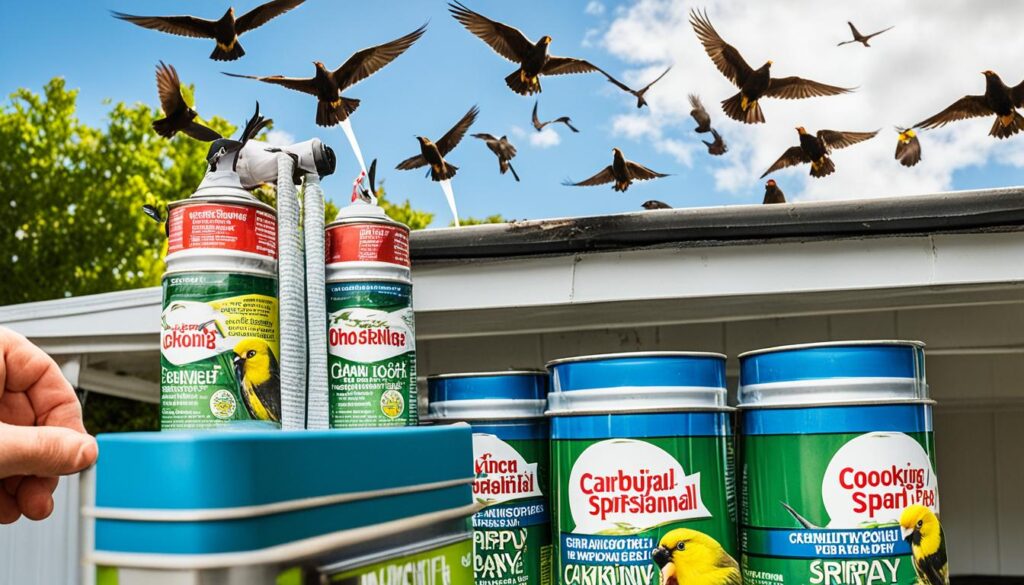
While non-stick cooking spray is a simple and effective solution, it’s important to note that it may need to be reapplied more frequently than some other bird deterrent methods. The spray can wear off over time, especially in areas exposed to the elements. By staying diligent and reapplying the spray as needed, you can maintain a bird-free carport and prevent any unwanted nesting activities.
“Using non-stick cooking spray is a clever and cost-effective way to keep birds out of your carport. The slippery surface makes it nearly impossible for them to build their nests, providing a reliable and hassle-free solution.”
In conclusion, using non-stick cooking spray is a practical and accessible way to prevent birds from nesting in your carport. By creating a slippery surface, you can effectively deter birds from establishing a home in your outdoor space. Remember to reapply the spray regularly to maintain its effectiveness and keep your carport bird-free.
Install Bird Spikes
Bird-control strips, also known as “porcupine wire” or “bird spikes,” are an effective solution for keeping birds out of your carport. These thin metal spikes protrude in multiple directions, making it impossible for birds to land and nest on the targeted areas, typically the top corners of the rafters. By installing these bird spikes, you can deter birds from establishing a presence in your carport.
Porcupine Wire on Rafters
The bird spikes, or porcupine wire, are designed specifically to prevent birds from nesting and perching on the rafters of your carport. These metal strips with sharp, angled spikes create an uninviting and inaccessible surface for birds, effectively deterring them from your carport. When installing the porcupine wire, focus on the areas where birds are most likely to land, such as the top corners of the rafters.
According to industry experts, 3/4″ bird netting with a mesh size of 3/4″ is recommended as it excludes birds completely from accessing the underside of the awning. Bird spikes are also specifically designed to stop Swallows and Bats from nesting and to prevent pigeons and seagull-sized birds from perching under awnings.
By installing these bird-control strips, you can keep your carport free from unwanted bird nests and droppings, maintaining a clean and well-protected environment. This simple and effective solution can help you maintain the appearance and cleanliness of your carport while deterring birds from making it their home.
“Bird spikes are an essential tool for keeping birds out of carports and protecting the integrity of the structure. They create an inhospitable environment that deters birds from nesting and perching, ensuring a clean and bird-free carport.”
Preventing New Birds
Maintaining a bird-free carport is an ongoing effort. To prevent new birds from establishing nests and taking up residence, it’s crucial to consistently implement the strategies and techniques discussed earlier. By proactively addressing the factors that attract birds, you can deter both existing and potential newcomers, ensuring a long-term solution for keeping your carport bird-free.
One of the key steps is to maintain the cleanliness of your carport. Regularly sweeping away debris, properly disposing of any food sources, and eliminating nesting materials can make the area less appealing to birds searching for a suitable home. Additionally, the use of reflective surfaces, such as mirrors or foil tape, can create a visually unappealing environment that discourages birds from attempting to settle in.
Incorporating physical barriers, like bird netting or spikes, is also essential for preventing new birds from gaining access to your carport’s rafters and other potential nesting sites. These deterrents must be consistently monitored and maintained to ensure their effectiveness over time.
Constant vigilance is key when it comes to keeping your carport bird-free. By diligently implementing and maintaining the bird-deterring measures, you can effectively prevent new birds from establishing themselves in your carport, ensuring a long-term solution for a well-protected outdoor space.
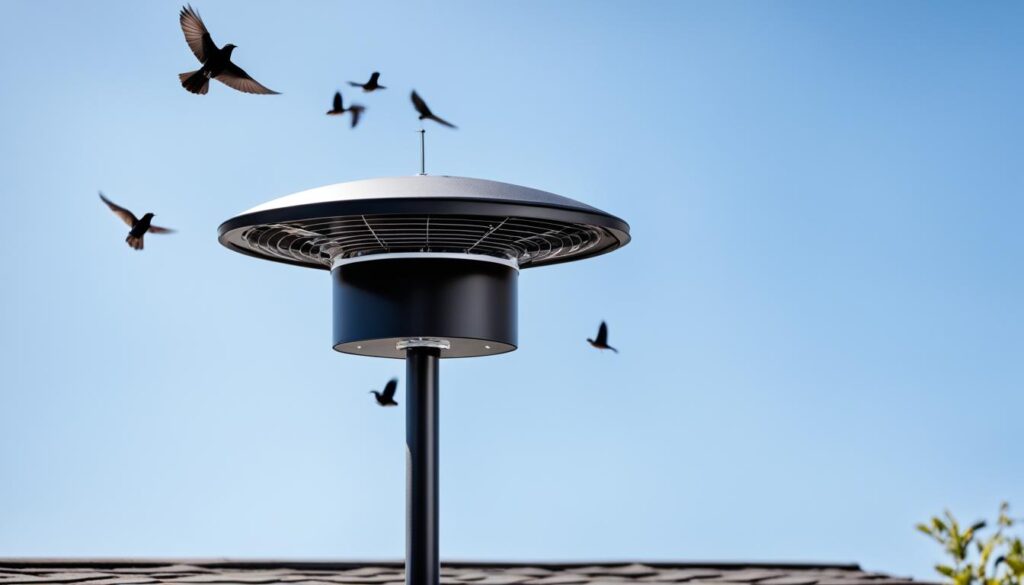
“The key to success in keeping birds away from your carport is consistency. By persistently implementing a range of deterrent strategies, you can create an environment that is unappealing and inaccessible to both existing and potential new bird residents.”
Remember, a proactive approach is essential when it comes to strategies to prevent new birds in carports. By staying vigilant and maintaining bird-deterring measures over time, you can enjoy a long-term solution for keeping birds away from your carport and preserving the cleanliness and aesthetics of your outdoor space.
Consider a New Carport
If you’re in the market for a new carport, it’s an excellent opportunity to select a design and features that are less attractive to birds. Certain carport configurations or materials may be less appealing to our feathered friends, making it easier to keep them away. Consulting with a reputable carport manufacturer, such as American Carports, Inc., can help you find a solution that is both functional and effective at deterring birds.
When choosing a carport to deter birds, look for features that make it less inviting for them to nest or perch. For instance, carports with smooth, non-porous surfaces or those that incorporate reflective elements can be less attractive to birds. Additionally, carports with fewer ledges or overhangs provide fewer nesting opportunities, discouraging birds from taking up residence.
Purchasing a new carport to prevent bird problems can be a wise investment. By choosing a carport design that is less appealing to birds, you can significantly reduce the likelihood of dealing with unwanted avian visitors and the associated messes and damages. This proactive approach can save you time, money, and headaches in the long run.
“Investing in a well-designed carport can be a game-changer when it comes to deterring birds and keeping your property clean and well-maintained.”
Remember, working with a trusted carport provider can help you identify the best features that make a carport less attractive to birds. This knowledge can be invaluable in purchasing a new carport to prevent bird problems and maintaining a clean, bird-free outdoor space.
Bird Deterrents for Porches
While the focus of this article has been on keeping birds out of carports, the same principles can be applied to other outdoor structures, such as porches. Employing bird deterrents for porches can be a effective way to prevent birds from nesting or roosting in these areas.
Reflective Surfaces and Cleanliness
One key strategy for deterring birds from your porch is to use reflective surfaces. Mirrors and foil tape can be strategically placed to create the illusion of predators or to simply disperse light in a way that discourages birds from landing. Additionally, keeping your porch clean by regularly sweeping and removing any potential food sources can help make the area less appealing to birds.
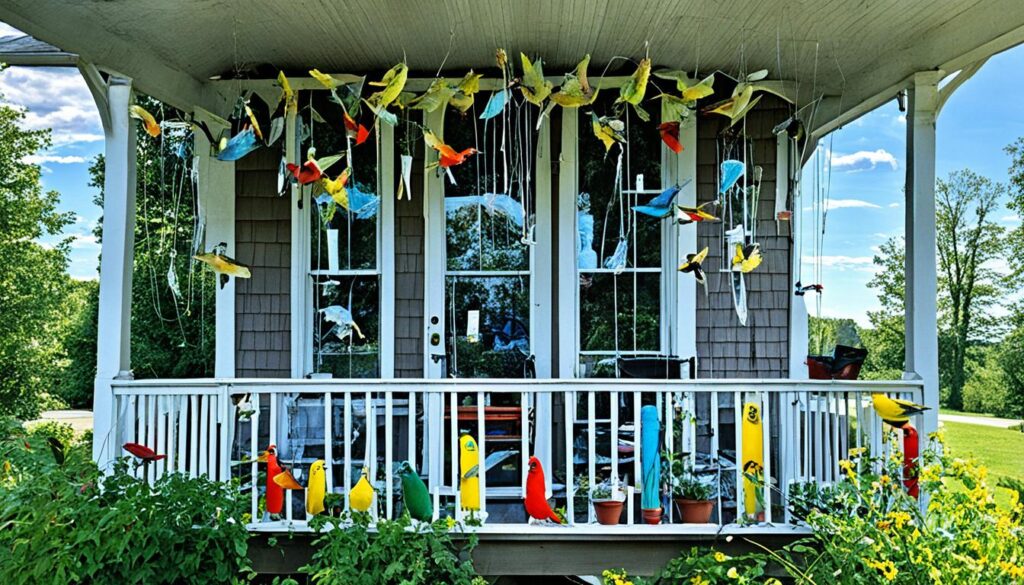
Reflective spinners, discs, and other shiny objects can also be effective in keeping porches clean to prevent birds from nesting. The movement and reflection of these items can scare birds away and discourage them from settling on your porch.
By employing a combination of reflective surfaces and maintaining cleanliness, you can create an environment that is less attractive to birds, effectively deterring them from your porch.
Dealing with Nesting Birds
If you’ve discovered existing bird nests in your carport, it’s crucial to take action to remove them. The presence of existing nests can lead to further issues, such as structural damage and increased bird activity in the area. Carefully removing any nests that have been built, while ensuring you do not harm any birds or their eggs, is a necessary step in fully addressing the problem of birds nesting in carports.
Removing Existing Nests
When it comes to addressing existing bird nests in carports, there are a few important considerations to keep in mind:
- Timing is critical – it’s best to remove nests before eggs have been laid or hatchlings have emerged. This will prevent any potential harm to the birds and their young.
- Use caution when handling the nest – wear gloves and take care not to damage the structure or contents. If there are any eggs or nestlings present, consult with a wildlife rehabilitation center for proper handling and care.
- Dispose of the nest properly – place it in a sealed container and discard it in accordance with local regulations. This will help prevent the birds from attempting to rebuild in the same location.
- Consider the species – certain birds, such as swallows, may be protected under federal or state laws. It’s essential to research the specific regulations in your area before removing bird nests from carports.
By taking these steps, you can effectively handle nesting birds in carports and prevent further issues from arising. Remember, it’s crucial to approach the situation with care and consideration for the well-being of the birds.
“Birds can become a nuisance when they stake a claim in sheds or garages, often undetected for weeks or months.”
Addressing existing bird nests in carports is an important step in maintaining a clean and safe environment. By following the proper procedures, you can effectively remove bird nests from carports while minimizing any potential harm to the birds or their young.
Mothballs as Bird Repellents
When it comes to keeping birds out of your carport, one potential solution is the use of mothballs. The strong, pungent smell of the ammonia in mothballs can act as a natural deterrent for many bird species, as they find the odor nauseating and unpleasant. By strategically placing mothballs around your carport, you may be able to discourage birds from attempting to nest or roost in the area.
However, it’s important to note that the use of mothballs as a bird repellent comes with some significant drawbacks. Mothballs are a caustic mixture of poisonous chemicals, typically containing naphthalene or paradichlorobenzene, which can release toxic gases when exposed to air or slight heat. Prolonged exposure to these hazardous chemicals can lead to a range of health issues, including extreme headaches, dizziness, difficulty breathing, and nausea.
Furthermore, the misuse of ammonia, a key ingredient in mothballs, can cause severe irritation of the respiratory tract, blindness, lung damage, birth defects, brain damage, and even death. The ammonia fumes in the air can also cause burning of the eyes, nose, and throat, and can turn into a deadly gas if mixed with other chemicals like bleach.
“Reactionary chemicals like ammonia and mothballs can have serious health effects on not only humans but also other animals.”
Given these significant health risks, the use of mothballs as a bird repellent is generally not recommended. Instead, consider more eco-friendly and safer alternatives, such as installing bird netting, using reflective surfaces, or introducing fake predators to your carport. These methods can effectively deter birds without exposing you, your family, and the surrounding environment to the hazardous chemicals found in mothballs.
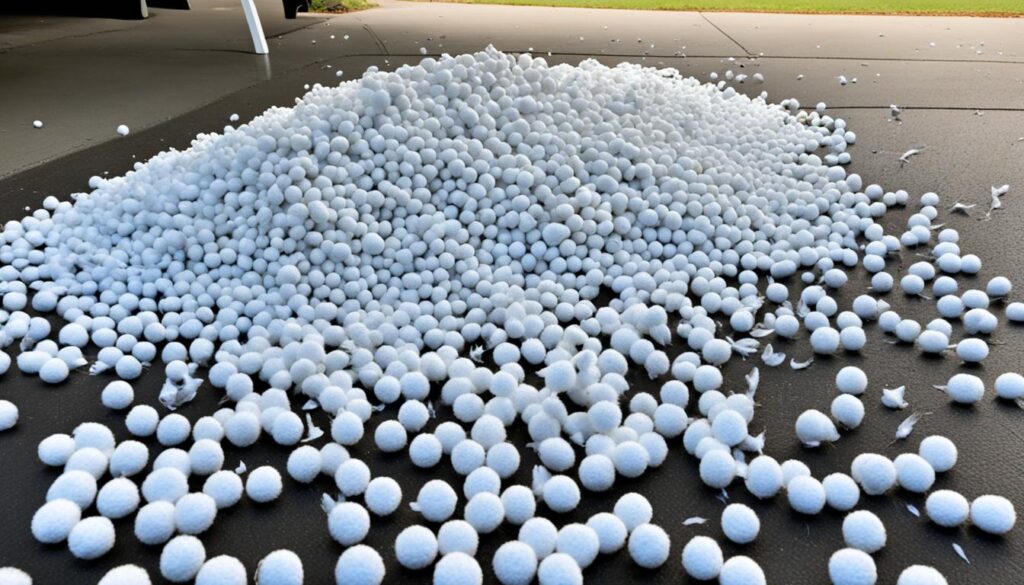
While mothballs may seem like a quick fix for keeping birds out of your carport, the potential health and environmental consequences far outweigh any potential benefits. By exploring safer and more sustainable bird deterrent options, you can effectively protect your carport while prioritizing the well-being of yourself, your loved ones, and the local wildlife.
Roof Damage from Bird Nests
While the unsightly appearance and mess caused by bird droppings can be a nuisance, allowing birds to nest in your carport can lead to more severe issues. The nesting materials and debris can clog gutters and cause damage to the roof and other structural components of the carport. Addressing the bird problem proactively is crucial to prevent these types of costly repairs down the line.
The potential damage from bird nests in carports can be significant. Bird nests can obstruct rainwater drainage, leading to water pooling on the roof and increasing the risk of leaks and structural damage. Additionally, the weight of the nests and the debris they contain can put stress on the carport’s framing, potentially causing cracks or even collapse over time.
The impact of bird nesting on carport structures is a serious concern. Bird droppings can corrode and degrade roofing materials, while the nesting materials can clog gutters and downspouts, leading to water damage. Furthermore, the debris from the nests can attract other pests, such as insects and rodents, further exacerbating the problem.
Allowing birds to nest in your carport can pose a significant risk. The risks of allowing birds to nest in carports include the potential for structural damage, fire hazards, and even the spread of zoonotic diseases. Proactive measures to deter birds from nesting in your carport are essential to protect your investment and maintain the integrity of your home’s structure.
To address the issue, it’s crucial to consider a range of bird deterrents, such as installing bird netting, using reflective surfaces, or employing methyl anthranilate-based repellents. By taking proactive steps to keep birds out of your carport, you can prevent costly repairs and ensure the long-term stability and safety of your carport structure.
Conclusion
In summary, there are numerous effective strategies and solutions available to keep birds out of your carport. By addressing the primary attractants, such as food sources and nesting opportunities, and employing a combination of physical barriers, repellents, and deterrents, you can successfully discourage birds from entering and nesting in your carport. Maintaining a proactive approach to bird control is essential for protecting your vehicles and preserving the integrity of your carport structure.
The key takeaways for keeping birds out of carports include regularly cleaning the area, installing bird netting and spikes, utilizing reflective surfaces and fake predators, and applying non-stick cooking sprays. Additionally, considering a new carport design or incorporating bird deterrents for porches can further enhance your efforts to prevent bird intrusions. Ultimately, a comprehensive and proactive bird control plan is crucial for maintaining a clean, bird-free carport environment.
By implementing these effective carport bird deterrents, you can safeguard your property, vehicles, and personal health from the risks associated with bird droppings and nesting activities. Staying vigilant and taking proactive measures will ensure your carport remains a secure and bird-free space for your daily needs.
FAQ
What attracts birds to carports?
The main factors that attract birds to carports are the availability of food sources and nesting opportunities. Birds may be drawn to carports in search of food scraps, debris, or other edible items. Additionally, the rafters and structural elements of a carport provide an ideal nesting location, as they offer protection from predators.
How can I keep my carport clean to deter birds?
Maintaining a clean and tidy carport is essential in deterring birds. Regular sweeping to remove leaves, debris, and any potential food sources can eliminate the attractants that draw birds to your carport. Additionally, ensuring that any food scraps or pet food are properly disposed of and not left in the carport will help reduce the presence of birds.
How can I protect the rafters in my carport from birds?
Installing bird netting across the underside of the rafters can create a physical barrier to prevent birds from accessing these areas and building nests. Bird netting is relatively affordable and easy to install, either by the homeowner or with the help of a contractor.
What natural bird repellent can I use in my carport?
Methyl anthranilate, a natural, non-toxic bird repellent derived from grapes, can be an effective solution. Unlike harsh chemical pest control methods, methyl anthranilate has a pleasant grape-like smell and is environmentally friendly. Regularly applying this substance around the carport can effectively deter birds from entering and nesting in the area.
How can reflective surfaces help keep birds out of my carport?
Reflective surfaces, such as mirrors and foil tape, can help discourage birds from entering your carport. The reflection can give the impression that the area is already occupied, causing birds to seek alternative nesting sites. Strategically placing flat mirrors or scattering small mirrors and strips of foil tape along the carport’s roof can effectively deter birds.
How can I use fake predators to keep birds away from my carport?
Introducing fake predators, such as artificial owls or snakes, can scare birds and prevent them from attempting to nest in the carport. For best results, it’s important to occasionally move the fake predators around to prevent birds from becoming accustomed to their presence.
Can non-stick cooking spray be used to deter birds from my carport?
Yes, a domestic solution for preventing birds from nesting in your carport is the use of non-stick cooking spray. When applied to the horizontal and vertical surfaces in the carport, the non-stick properties of the spray can make it difficult for birds to build their nests, effectively discouraging them from attempting to establish a home in your carport.
What are bird-control strips, and how can they help keep birds out of my carport?
Bird-control strips, also known as “porcupine wire” or “bird spikes,” are an effective solution for keeping birds out of your carport. These thin metal spikes protrude in multiple directions, making it impossible for birds to land and nest on the targeted areas, typically the top corners of the rafters. By installing these bird spikes, you can deter birds from establishing a presence in your carport.
How can I prevent new birds from entering my carport?
Preventing new birds from entering your carport is crucial for long-term success in keeping the area bird-free. The strategies and techniques discussed, such as maintaining cleanliness, using deterrents, and installing physical barriers, should be consistently implemented to discourage both existing and potential new birds from considering your carport as a nesting site.
How can the design of a new carport help keep birds away?
If you are in the market for a new carport, it’s an opportunity to select a design and features that are less attractive to birds. Some carport configurations or materials may be less appealing to birds, making it easier to keep them away. Consulting with a reputable carport manufacturer can help you find a solution that is both functional and effective at deterring birds.
Can the same bird deterrents used for carports be applied to porches?
Yes, the same principles can be applied to other outdoor structures, such as porches. Employing reflective surfaces, like mirrors and foil tape, and maintaining cleanliness by regularly sweeping and removing potential food sources can also be effective in deterring birds from nesting or roosting on your porch.
What should I do if I find bird nests in my carport?
If you have already discovered bird nests in your carport, it’s important to take action to remove them. Existing nests can lead to further issues, such as damage to the structure and increased bird activity. Carefully removing any nests that have been built, while ensuring you do not harm any birds or their eggs, is a necessary step in fully addressing the problem.
Can mothballs be used to keep birds out of my carport?
Yes, another potential solution for keeping birds out of your carport is the use of mothballs. The ammonia in mothballs can be a deterrent to many bird species, as the strong smell is generally nauseating to them. Strategically placing mothballs around the carport may help discourage birds from attempting to nest or roost in the area.
Why is it important to address bird nesting in my carport?
In addition to the unsightly appearance and mess caused by bird droppings, allowing birds to nest in your carport can also lead to more serious issues. The nesting materials and debris can clog gutters and cause damage to the roof and other structural components of the carport. Addressing the bird problem proactively is crucial to prevent these types of costly repairs down the line.
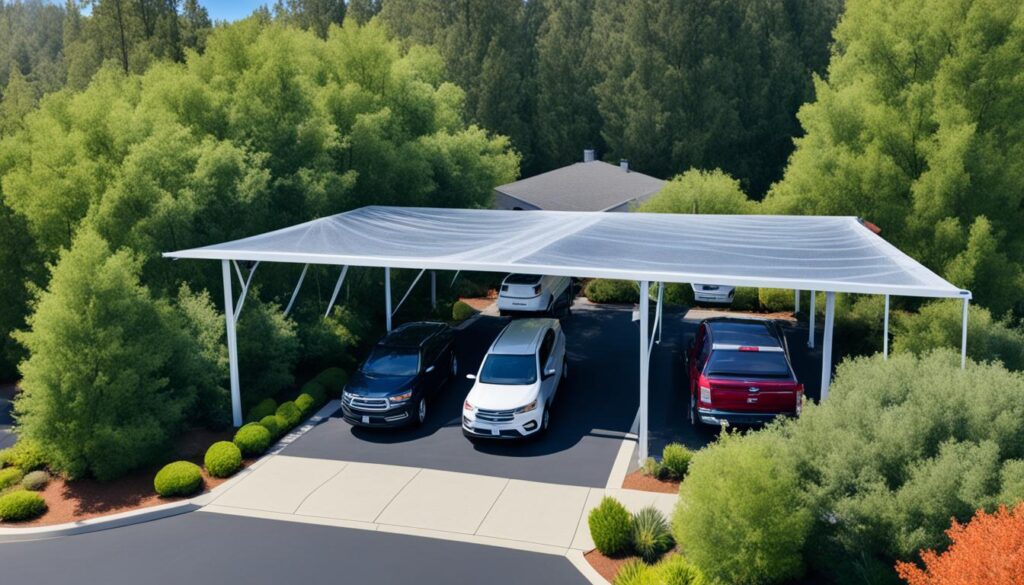

Good day! Do you know if they make any plugins to
help with Search Engine Optimization? I’m trying to get my
website to rank for some targeted keywords but I’m
not seeing very good gains. If you know of any please share.
Appreciate it! You can read similar article here: Bij nl
Hello! Do you know if they make any plugins to assist with Search Engine Optimization? I’m trying to get my blog to rank
for some targeted keywords but I’m not seeing very good results.
If you know of any please share. Kudos! You can read similar article here: Change your life
I am really impressed along with your writing talents and also with the format
to your weblog. Is that this a paid subject or did you customize it your self?
Either way keep up the nice high quality writing, it is uncommon to look a nice blog like this one these days.
Snipfeed!
I’m really inspired with your writing talents and also with the layout to your blog.
Is this a paid subject or did you modify it your self? Anyway keep up the nice quality writing,
it is rare to look a nice blog like this one today. Stan Store!
I am extremely impressed together with your writing abilities and also with the structure for your weblog. Is this a paid topic or did you customize it your self? Either way keep up the excellent quality writing, it is rare to see a nice blog like this one these days. I like talkbirds.com ! It’s my: Madgicx
I’m really impressed with your writing talents and also with the
layout for your weblog. Is this a paid subject or did you modify it
your self? Either way keep up the excellent high quality
writing, it is uncommon to see a nice weblog like this one today.
Stan Store!
Hi friends, its wonderful paragraph on the topic of cultureand entirely
defined, keep it up all the time.
Feel free to surf to my web blog; nordvpn coupons inspiresensation [t.co]
Thanks a lot for sharing this with all of us you actually realize what you are
speaking about! Bookmarked. Please additionally consult with my website =).
We may have a hyperlink trade contract between us
my web-site: nordvpn coupons inspiresensation
350fairfax nordvpn special coupon code 2025
Howdy! Someone in my Facebook group shared this site with us so I came to
look it over. I’m definitely enjoying the information. I’m
book-marking and will be tweeting this to my followers! Excellent blog and fantastic design.